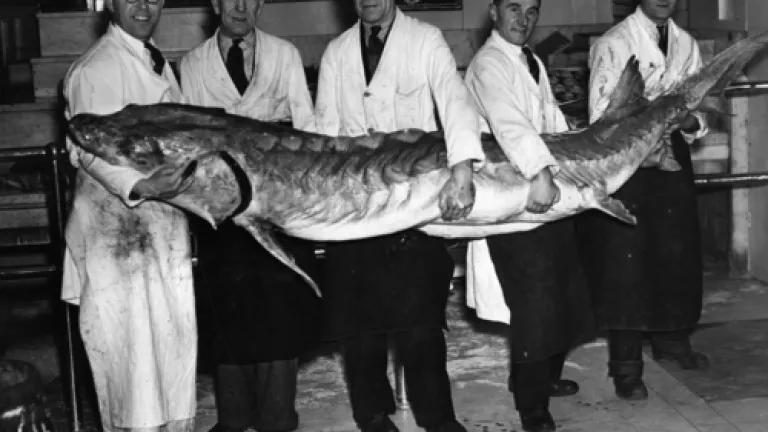
Our oceans are home to any number of remarkable, even bizarre, creatures. Today, one of the country’s largest—the Atlantic sturgeon—has officially been protected under the Endangered Species Act (ESA). This marvelous, armor-plated fish can reach 14 feet and more than 800 pounds, and has a long snout with sensitive barbells, dangling feelers that, like a catfish’s “whiskers,” help the creature find food from ocean and river floors. But because of a myriad of harms, Atlantic sturgeon no longer dwell in many of their historic rivers and most of the remaining support only remnant spawning populations.
To prevent the Atlantic sturgeon from vanishing entirely, NRDC filed a petition in September of 2009 to list the fish under the ESA. Today, the petition was granted: the National Marine Fisheries Service (NMFS) listed four distinct population segments (DPSs, which are treated as individual species under the law) as endangered: the New York Bight, the Chesapeake Bay, the Carolina, and the South Atlantic. All “take” of the fish—e.g., killing, collection, and harassment—is prohibited without a permit. The northernmost DPS, the Gulf of Maine, will be listed as threatened. The agency announcement says the listing will be published in the Federal Register on Feb. 6th.
Sturgeons co-existed with the dinosaurs, as befits their size and armor (the sides of sturgeons are lined with hard protruding plates called scutes). Atlantic sturgeon as a specific species hail from the Pleistocene epoch, from last ice age, 13,000 years ago. In the 1800s, huge numbers of Atlantic sturgeon were still swimming in rivers from Maine to Florida. The Delaware River alone supported an estimated population of more than 180,000 sturgeons. Now, just two rivers are believed to support more than 300 spawners (and the Delaware, formerly the county’s largest, isn’t one of them). For such depleted populations, any unusual loss, in any given year, could be a threat to long-term existence. Moreover, sturgeon grow and reproduce incredibly slowly. An anadramous fish (like salmon), they mature at sea before spawning in the river where they were born. On average, female Atlantic sturgeon first spawn at 15 years of age, and at two- to five-year intervals from then on. Since Atlantic sturgeon live to be 60, it takes three decades for a female to live up to just half her potential.
Atlantic sturgeon must negotiate a veritable minefield of dangers as they migrate up and down the coast and then, once they reach spawning age, make their way up their natal rivers and back down again. Over a century ago, before the fishery crashed, commercial harvest of Atlantic sturgeon for flesh and caviar peaked at 3,700 tons in a year. Fishing for them has been prohibited since 1998, but Atlantic sturgeon is often accidentally caught (what’s known as “bycatch”); for example, they become entangled in gill nets near the ocean floor, and suffocate. And sturgeon confront many other hazards, some of which are plain to see: dams impede passage to large spawning stretches, for instance, while dredging to maintain or deepen shipping channels destroys firm, prey-rich river and ocean bottom that sturgeon rely on and pollutes the water.
Many other hazards are less obvious to the eye, but no less real. For example, sturgeon are highly vulnerable to low dissolved oxygen levels, such as caused by “eutrophication,” which occurs when high levels of pollutants like nitrogen and phosphorus cause algal blooms that leach oxygen from the water. Like dams, these invisible “hypoxic zones” become a deadly blockade for spawning sturgeon and other fish. Global warming exacerbates these conditions (for example, warmer waters hold less oxygen) and is generally making things less hospitable for this cool water fish.
Species survival is a measure of the health of our natural planet. That such a monstrous fish swam alongside dinosaurs—and then out swam their mass extinction—should give us hope that, with our protection, it will survive, and so will many other species. This fish is one that every kid in the country, while passing through his or her dinosaur phase, should learn of, to total amazement. But just think how stunned that same child then would be to hear that the Atlantic sturgeon continues to exist—and that we helped bring it back from the brink, for them to see.

